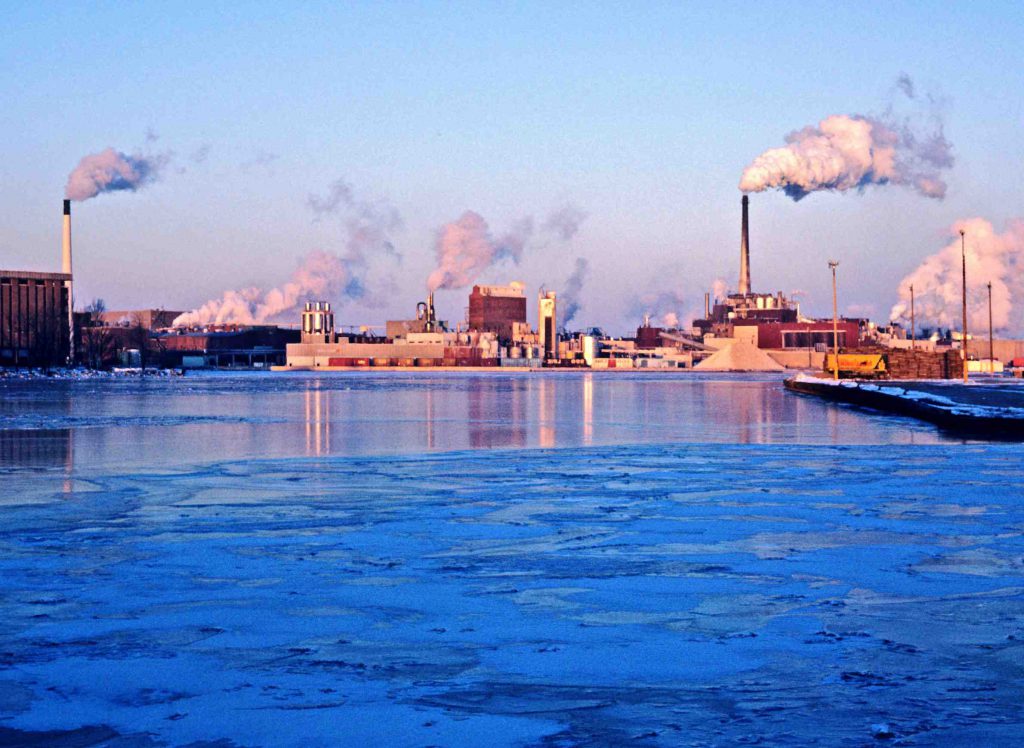State Meets Federal Air Quality Standard
Improvements in Rhinelander area bring entire state in compliance on sulfur dioxide standard.

Paper mills are a longstanding Wisconsin industry, and can be found around the state, including on the Fox River in Green Bay. Photo from the Wisconsin Department of Natural Resources (CC BY-ND 2.0)
Federal and state environmental regulators announced Wednesday that the Rhinelander area has met the most recent federal air quality standard for sulfur dioxide, bringing the entire state into compliance.
The pollutant largely stems from burning fossil fuels at power plants and other industrial facilities. The Ahlstrom-Munksjö paper mill in Rhinelander was primarily responsible for the area’s emissions.
The U.S. Environmental Protection Agency set an hourly primary standard of 75 parts per billion in 2010 due to evidence that shows health risks linked to short-term exposures. Sulfur dioxide pollution can harm the respiratory system and worsen asthma, especially for children. The emissions can also lead to acid rain, damage crops and increase haze.
Regulators reviewed air quality data from 2011 to 2013 and designated a portion of Oneida County near Rhinelander as “nonattainment” in 2013. The designation was based on readings from an air monitor that recorded levels of roughly 150 parts per billion — double the standard.
State and federal regulators say the area is now meeting standards for all air pollutants regulated under the National Ambient Air Quality Standard, benefiting 18,000 residents in the area.
“People in the Rhinelander area are breathing cleaner, healthier air due to EPA’s partnership with the state of Wisconsin,” said EPA Region 5 Administrator Debra Shore in a statement on Wednesday. “Reducing sulfur dioxide pollution in the air is especially helpful for vulnerable populations.”
The DNR in collaboration with the EPA worked with the mill to identify and put new pollution control measures in place. The state came up with a plan to bring the mill into compliance, which the EPA reviewed and approved.
“Some of the actions included the retirement of four coal-fired boilers. They also changed their coal supply to reduce the sulfur content at the paper mill,” said Jason Treutel, chief of the DNR’s air quality planning and standards section.
Doug Aburano, the EPA’s air programs manager in Region 5, said those changes along with tighter emission controls on the mill’s one remaining coal boiler have prompted levels in the area to drop to just under 40 parts per billion.
“It shows that the Clean Air Act is working, and that the plan that Wisconsin submitted, has worked and really lowered the amount of pollution in the air,” said Aburano.
The mill completed many of those changes in 2015, according to the DNR. However, the regulations rely on a three-year average of concentrations to determine whether standards are being met. The area reached compliance in 2018, and regulators moved to redesignate the area as “attainment” or meeting the standard.
Federal and state regulators say the mill’s actions reduced sulfur dioxide emissions by more than 75 percent.
In a statement, a spokesperson for Ahlstrom-Munksjö said sustainability is “top of mind” for the mill.
“(W)e are committed to creating fiber-based solutions that lead to a more sustainable life. Part of this commitment is ensuring we are contributing to our communities. Therefore, we are pleased to see the positive results from the significant capital expenditures we have made to our facility, while working in partnership with Wisconsin DNR and the EPA,” said Addie Teeters, the mill’s head of marketing.
Over the last 20 years, sulfur dioxide emissions from large sources like paper mills and power plants have decreased by 92 percent in Wisconsin.
“(W)ith most of this decline attributable to the use of cleaner-burning fuels at power plants and industrial facilities, along with the introduction of low-sulfur diesel fuels,” said Gail Good, the DNR’s acting environmental management division administrator, in a statement.
Average concentrations of sulfur dioxide have dropped nationwide by about 85 percent during the same timeframe, according to the EPA.
Entire state meets 2010 air quality standard after Rhinelander mill reduces sulfur dioxide pollution was originally published by Wisconsin Public Radio.
If you think stories like this are important, become a member of Urban Milwaukee and help support real, independent journalism. Plus you get some cool added benefits.
















